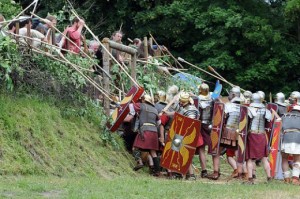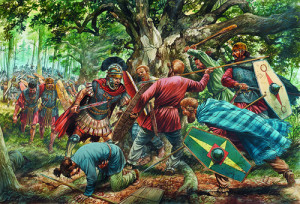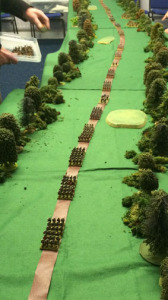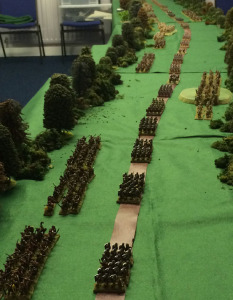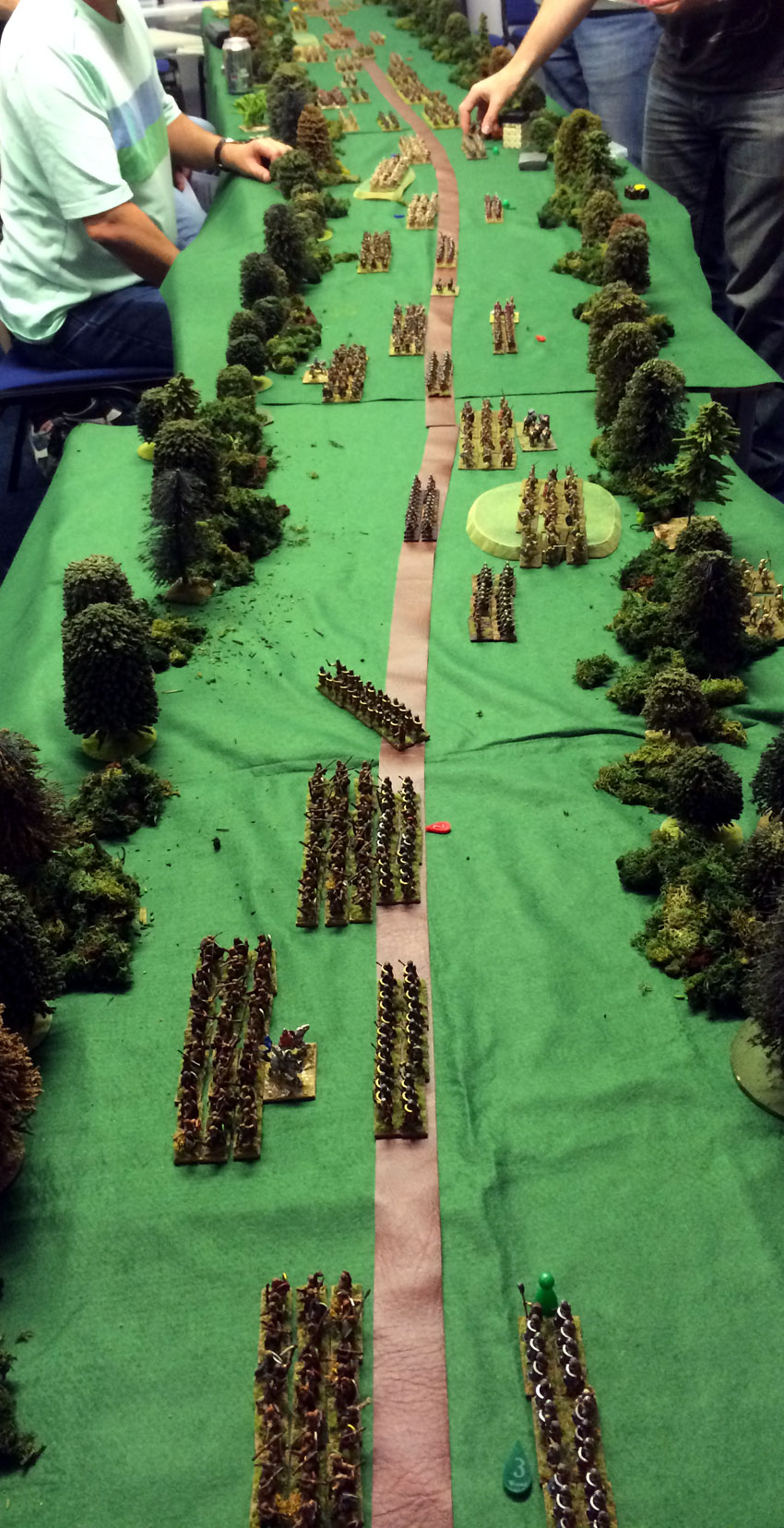The disaster at Teutoburger Wald was decisive only insofar as it drove the Romans back across the Rhine. The German tribes lacked the capacity to follow-up and were in any event satisfied with regaining their autonomy. Despite a few forays which amounted to little strategically but got the by Tiberius, w future emperor a Triumph, the Romans stayed behind the safety of the river. They were still profoundly shocked by Varus’s defeat, and the Empire could not spare the resources to mount a major invasion into German territory. Both sides therefore, watched each other warily but in relative comfort. But history suggests that Romans, like elephants, never forget, and they would be back. It would not be Tiberius who would lead the Roman retaliation but Germanicus, the great nephew of Augustus and adopted son of Tiberius.
For our 3rd game in the campaign we try to represent the recapture of the Eagle of the XIX. The format of the game was far more ‘straight up’ than in the previous two games. The roman field was formed up arrayed for battle. There were 7 objective dotted around the table, 3 of these would be potential spots for the Eagle. Each of these 3 would give the Romans a 33% of winning the game. Anything else would be a German victory. The other 4 would have some random effect on the game, because I like the moans and groans of that this generates.
In 14AD the Senate appointed Germanicus to take command of the armies on the Rhine at a time when the soldiers were in a state of mutiny. The major issues were the terms and conditions of service, including a brutal disciplinary regime. Germanicus was highly popular with the rank and file, and he solved the crisis through appeals to loyalty and selective purges of mutineers. He also adopted the tried and trusted method of leading his into the troops out field. Their target was the completely unsuspecting Marsi. Germanicus advanced with a caution that might have saved Varus had he adopted the same methods. He made sure the route was properly scouted and that his flanks and rear were well protected at all times. For the attacking Germans, ambushing a rabble was one thing, but taking on a disciplined Roman army quite another. Despite their best efforts to cause disruption, the frantic warriors could not break the Roman formations and were quite easily repulsed Germanicus laid waste to a broad swathe of German territory before returning to winter quarters. The following spring Germanicus was back, this time pushing into Chatti territory. Through the ame methodical approach, he captured and burned their capital and dispersed the survivors. Germanicus split his forces and gave command of the smaller army to Aulus Caecina who promptly defeated the Cherusci
Probably seeing the writing on the wall, Arminius’s besieged rival chieftain Segestes who appealed to Germanicus for relief. The Roman commander was happy to oblige and rescued Segestes along with much of the plunder taken from Varus, and captured Arminius’s wife. For this and his general success, Germanicus was given the title Imperator. Arminius, on the other hand, was incensed at this personal and military setback and exhorted the tribes to redouble their efforts against the Romans. The prospect of the German tribes reunifying under a rejuvenated Arminius alarmed Germanicus. He therefore decided to hit the Germans while they were mobilizing. He ordered Caecina to march through the Bructeri and instructed the cavalry commander Pedo to attack the Frisii Germanicus put four legions on board ships and sailed through the lakes to meet his subordinate commanders at the River Amisia. Once that was affected, he despatched flying a column under Lucius Sertinus against the Bructeri. In a lightning campaign he routed the German tribe and in doing so recaptured the lost Eagle of Legion XIX.
The Germans slowly appear out of the mist
Germanicus followed up with another destructive march through German territory in the region of the Teutoburger Wald. With no local opposition in the area, Germanicus took the opportunity to visit the site of the his massacre with army. It was therefore thoroughly sobered Roman army that a set off in pursuit of Arminius. Arminius was a master ambush and proved it again when at Germanicus’s cavalry pursued the Germans across the plains and into the Wald. The retreating warriors suddenly turned joined by others hidden in the woods and fought back the cavalry and an infantry reserve help Only sent to tory the timely arrival of Germanicus with the main army prevented a minor disaster. Seeing no advantage in further pursuit, Germanicus decided to withdraw by boat, but not Caecina and his divisions to march home by way of a narrow road surrounded by as the Long marshes and hills known his ridges. Arminius followed Caecina, waiting for moment to pounce. Caecina’s predicament was that he was in hostile territory surrounded by a fearsome enemy, and his path home urgent repairs. He hunkered down while his own engineers set to work under armed protection. The Germans skirmished relentlessly with the Romans, trying to get at the engineers. They had the advantage of being more lightly armoured than the Romans, as well as knowing the terrain
Probably seeing the writing on the wall, Arminius’s besieged rival chieftain Scgestes who appealed to Germanicus for relief. The Roman commander was happy to oblige and rescued Segestes along with much of the plunder taken from Varus, and captured Arminius’s wife. For this and his general success, Germanicus was given the title Imperator. Arminius, on the other hand, was incensed at this personal and military setback and exhorted the tribes to redouble their efforts against the Romans.
The prospect of the German tribes reunifying under a rejuvenated Arminius alarmed Germanicus. He therefore decided to hit the Germans while they were mobilizing. He ordered Caecina to march through the Bructeri and instructed the cavalry commander Pedo to attack the Frisii. Germanicus put four legions on board ships and sailed through the lakes to meet his subordinate commanders at the River Amisia. Once that was effected, he despatched flying a column under Lucius Stertinus against the Bructeri. In a lightning campaign, he routed the German tribe and in doing so recaptured the lost Eagle of Legion XIX. Germanicus followed up with another destructive march through German territory in the region of the Teutoburger Wald. With no local opposition in the area, Germanicus took the opportunity to visit the site of the massacre with his army. It was therefore thoroughly sobered Roman army that a set off in pursuit of Arminius.
Arminius was a master ambush and proved it again when at Germanicus’s cavalry pursued the Germans across the plains and into the Wald. The retreating warriors suddenly turned joined by others hidden in the woods and fought back the cavalry and an infantry reserve help. Only the timely arrival of Germanicus with the main army prevented a minor disaster. Seeing no advantage in further pursuit Germanicus decided to withdraw by boat, but not Caecina and his divisions to march home by way of a narrow road surrounded by marshes and hills known the Long Bridges. Arminius followed Caecina, waiting for moment to pounce.
As a brief synopsis of our game. One of the random event was that the Germans we’re allowed an ambush as a largely undetermined position. This turned out to be right in the middle of the roman lines. The 3 large warbands were outnumbered, but could dealt a lot of damage and potentially dishearten the Romans. However, the dice determined that the Romans were not to be trifled with and this large ambush was swept away for no lose, and the Romans could advance unimpeded. In FoG:AM the Germans are at at 16% disadvantage. During the initial clash they are evens, but they then suffer for the remainder of the melee. They have to be lucky initially otherwise they will be ground down by the Roman mincing machine. Largely the Germans were not lucky, and with much wailing and gnashing of teeth the Romans held them back and slowly destroyed there barbarian foes. The scenario rules meant that the Germans would fight on past there normal army break, while the Romans had to be precious about their loses.
After 3 hours the Romans has captured 2 of the 3 objectives where the Eagle would be found. After much slaughter the Germans felt aggrieved (seemingly forgetting the joyous destruction of the Romans in the earlier games)… However, when it came to see who had won the game. The dice was thrown … 1-4 (2 objectives) Roman win, 5-5 (1 objective) German victory. The dice came up 6. German victory.
So in our campaign the Germans are 3 games up to none
Notable highlights.
- Lynnette throwing double six , followed by a successive 11 to kill both of Peters generals in the melee. Despite this set back Pete was the only German player to cause the Legions any inconvenience.
- Simon who excelled himself with his moaning at his lot in the game. Noted for his moaning, he went above and beyond in his pursuance to find misery in a club game 😉













